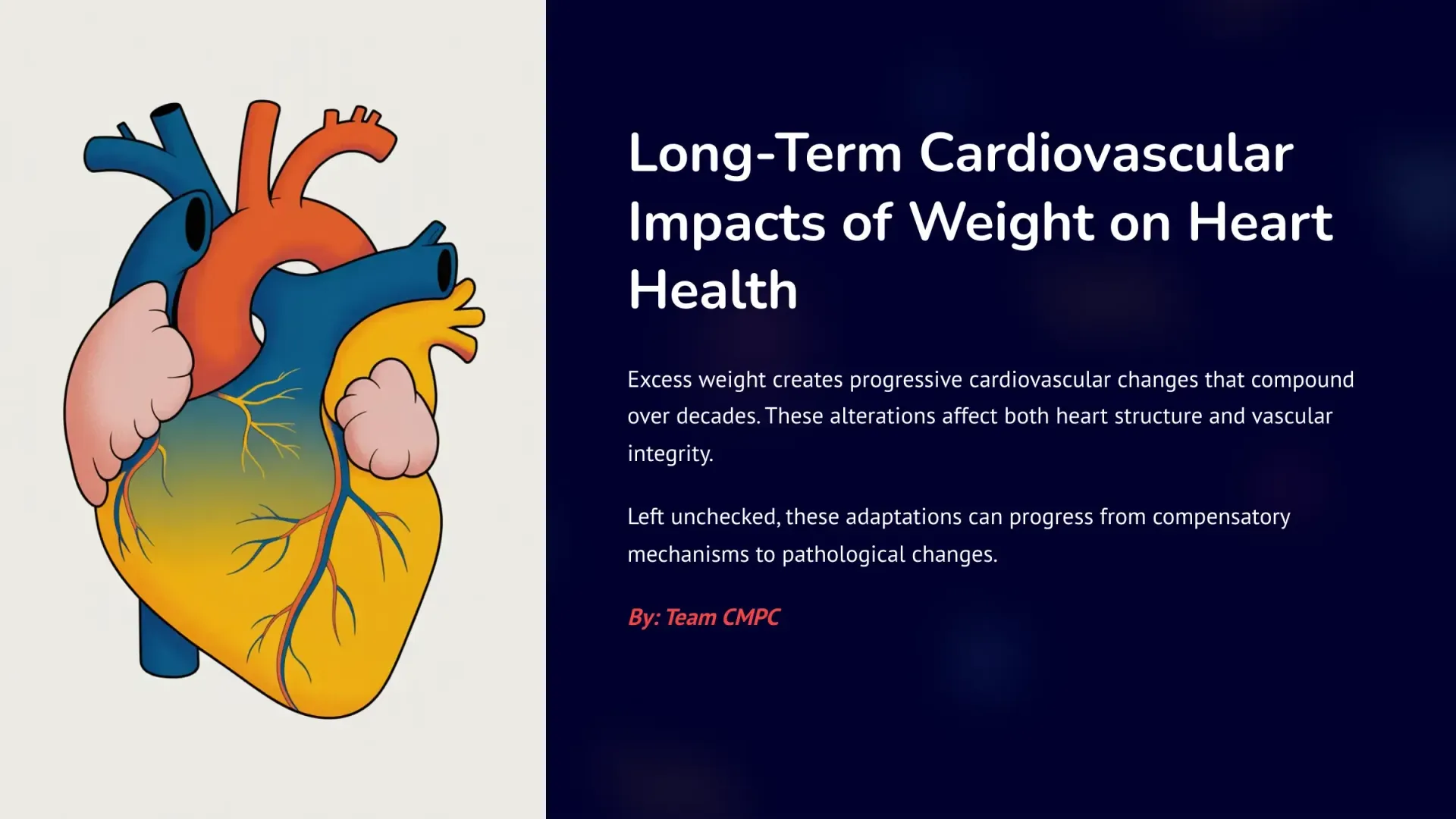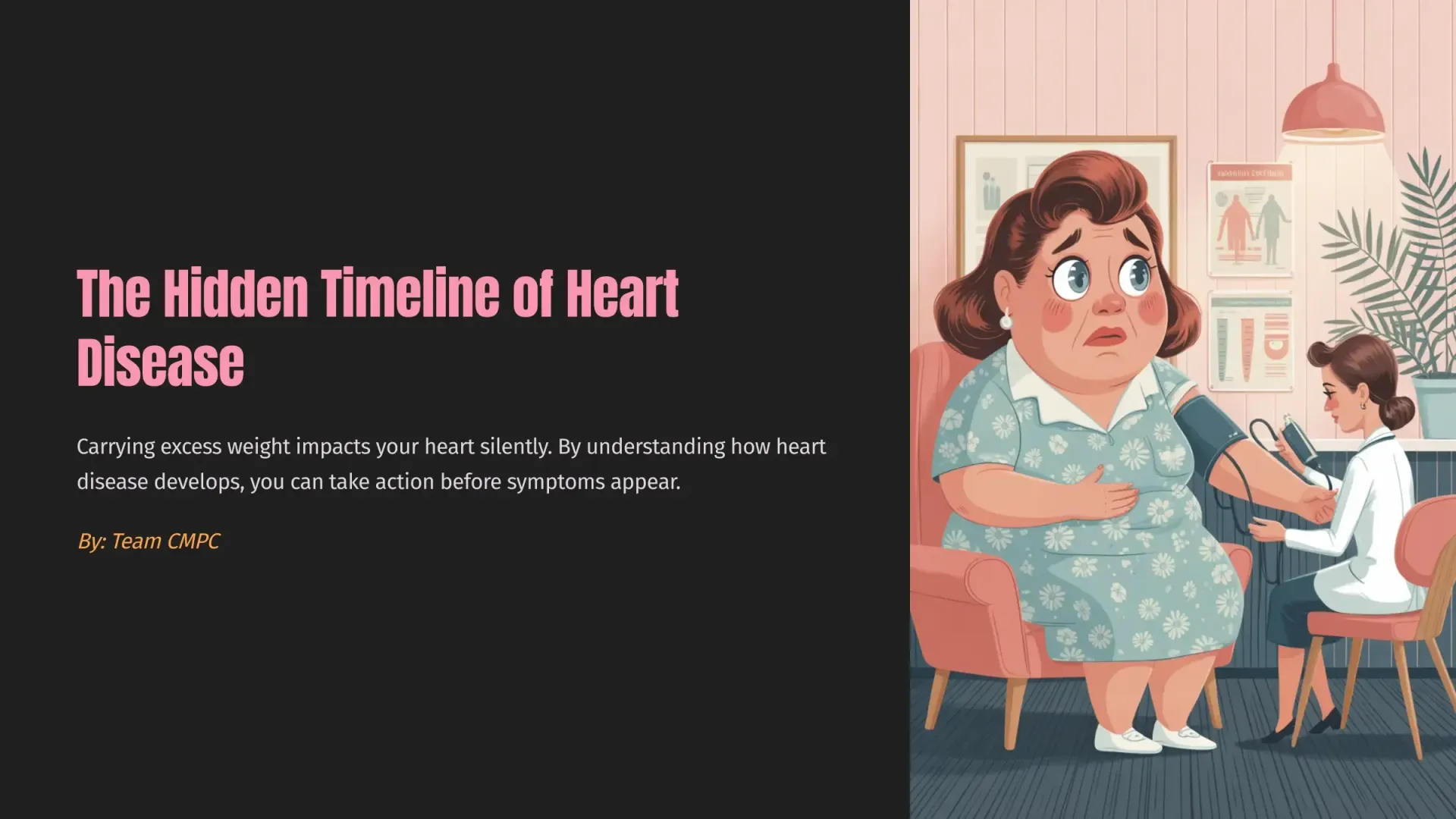
This is a subtitle for your new post
Numerous patients in Ottawa are worried about the potential impact of their weight on their health as they grow older. This concern is valid and crucial, as recognizing the long-term consequences of excess weight can encourage individuals to make positive lifestyle changes and well-informed healthcare choices.
At Chatterjee Medicine Professional Corporation (CMPC), we adopt a holistic weight management approach that addresses urgent health issues and long-term wellness. This in-depth guide will examine the impact of excess weight on different body systems over time, emphasizing cardiovascular health, joint functionality, and overall well-being.
Grasping the Progressive Nature of Weight-Related Health Impacts
Weight-related health effects typically develop gradually over time. For many Ottawans, the accumulation of excess weight happens slowly, perhaps a few pounds each year, which can make it challenging to connect weight changes with emerging health concerns. However, research demonstrates that the duration of obesity is a significant factor in determining health outcomes.
The Cumulative Effect of Excess Weight
Much like compound interest in finance, the health effects of excess weight can compound over time:
- Early stages: Metabolic changes may be present but with few noticeable symptoms
- Middle stages: Symptoms begin to emerge, such as joint pain, reduced energy, or elevated blood pressure
- Later stages: Chronic conditions develop and may start to interact with one another
Addressing these health concerns is increasingly vital for residents who have maintained excess weight for many years. The good news is that positive changes at any stage can help reduce risks and improve quality of life.

Long-Term Cardiovascular Impacts: How Weight Affects Heart Health Over Time
Progressive Changes to Heart Structure and Function
Many of our patients are surprised to learn how excess weight gradually changes the physical structure and function of the heart. Over time, carrying extra weight causes:
Increased blood volume: Your body must supply blood to all tissues, including fat. More body mass means more blood volume, requiring your heart to pump more blood each beat.
Left ventricular hypertrophy: To handle this increased workload, the left ventricle (the heart's main pumping chamber) often enlarges and thickens, a condition called hypertrophy. While initially a compensatory mechanism, over time, this can lead to:
- Decreased pumping efficiency
- Increased risk of heart rhythm abnormalities
- Heart muscle stiffening, making it harder for the heart to fill appropriately between beats
Fat deposition around the heart: Excess pericardial fat (fat surrounding the heart) can:
- Physically restrict heart movement
- Release inflammatory substances that directly affect heart muscle
- Increased risk of coronary artery disease
Electrical system changes: The heart's electrical system controls heart rhythm and undergoes alterations that increase the risk of arrhythmias like atrial fibrillation.
Long-Term Blood Vessel Changes
In our cardiovascular assessments, we often observe how excess weight affects blood vessels throughout the body:
Endothelial dysfunction: The endothelium (inner lining of blood vessels) becomes less responsive, reducing its ability to regulate blood flow and pressure.
Arterial stiffening: Arteries lose elasticity over time, increasing blood pressure and making the heart work harder.
- Atherosclerosis acceleration: The process of plaque buildup in arteries occurs more rapidly with:
- Increased inflammation from fat tissue
- Higher levels of circulating lipids
- Changes in blood clotting factors
- Microvascular damage: Tiny blood vessels throughout the body, especially in organs like the kidneys and eyes, can sustain cumulative damage.
The Timeline of Heart Disease Development
For many residents with excess weight, cardiovascular changes follow a typical progression:
- Years 1-5 of excess weight: Subtle changes in blood pressure, cholesterol levels, and inflammatory markers
- Years 5-15: Development of hypertension, dyslipidemia, and early insulin resistance
- Years 15+: Increased risk of major cardiovascular events such as heart attack and stroke
Studies show that for each decade lived with obesity, the risk of cardiovascular mortality increases by approximately 10%. However, this risk is modifiable with appropriate interventions at any stage.

Joint Health and Mobility: The Cumulative Impact of Weight on Your Musculoskeletal System
Mechanical Stress on Weight-Bearing Joints
Joint concerns rank among the most frequent complaints for patients carrying excess weight. The mechanical stress on joints increases proportionally with body weight, but the relationship isn't simply linear:
- For every pound of excess weight, approximately 4 pounds of additional pressure is placed on the knees when walking
- For every 5-pound weight gain, overall pressure on knee joints increases by 15-30 pounds during daily activities
- This pressure is multiplied during activities like climbing stairs or running
Over time, this excess pressure leads to:
- Accelerated cartilage wear: The protective cushioning between joints degrades faster under excess pressure.
- Joint space narrowing: As cartilage thins, the space between bones decreases, leading to bone-on-bone contact.
- Osteophyte formation: The body forms bone spurs in response to joint stress, which can further restrict movement and cause pain.
- Biomechanical adaptations: People often change how they walk or move to accommodate joint pain, creating additional stress on other joints and muscles.
Inflammatory Effects Beyond Mechanical Stress
Recent research reveals that the relationship between excess weight and joint problems extends beyond simple mechanical pressure:
- Adipokines: Fat tissue releases pro-inflammatory proteins called adipokines that can directly affect joint tissues
- Systemic inflammation: Chronic, low-grade inflammation associated with excess weight accelerates joint degeneration
- Metabolic factors: Changes in glucose metabolism and other metabolic parameters can negatively impact cartilage and bone health
Progressive Timeline of Joint Deterioration
For residents with excess weight, joint changes often follow this pattern:
- Early stage: Occasional discomfort after extended activity, particularly in knees, hips, and lower back
- Middle stage: Regular pain with activity, morning stiffness, and the beginning of mobility limitations
- Advanced stage: Chronic pain, significant mobility restrictions, and potential disability
Impact on Physical Activity and Quality of Life
One particularly challenging aspect of weight-related joint problems is how they cyclically affect physical activity:
- Excess weight places stress on joints
- Joint pain develops and makes physical activity uncomfortable
- Physical activity decreases
- Muscle strength and joint support diminish while weight may increase
- Joint stress increases further
This cycle can significantly impact the long-term quality of life for residents, affecting:
- Independence in daily activities
- Participation in family and social events
- Mental well-being and mood
- Sleep Quality
- Occupational performance
Learn more about how excess weight impacts your energy levels and daily activities in our article How Does Being Overweight Affect My Sleep and Energy Levels?
Respiratory System: How Weight Affects Breathing Function Over Time
Progressive Changes to Breathing Mechanics
'The varying seasonal conditions can exacerbate breathing difficulties for those with excess weight. Over time, extra weight affects respiratory function through:
Restricted chest wall movement: Excess tissue around the chest reduces the ability of the rib cage to expand fully.
Decreased lung volumes: Studies show a progressive reduction in:
- Total lung capacity
- Functional residual capacity (volume of air remaining in lungs after usual exhalation)
- Expiratory reserve volume (additional air that can be forcibly exhaled)
Increased respiratory effort: Breathing requires more energy, which can lead to:
- Sensation of breathlessness with minimal exertion
- Respiratory muscle fatigue
- Reduced exercise tolerance
Sleep-Disordered Breathing: A Progressive Condition
Sleep apnea may be the most significant respiratory concern for patients with excess weight. This condition often worsens over time if weight remains elevated:
- Early stage: Mild snoring and occasional breathing pauses
- Intermediate stage: Regular snoring, frequent breathing interruptions, and daytime sleepiness
- Advanced stage: Severe sleep disruption with hundreds of breathing pauses per night, significant oxygen desaturation, and serious cardiovascular complications
The long-term consequences of untreated sleep apnea include:
- Resistant hypertension
- Increased risk of heart attack and stroke
- Cognitive impairment
- Mood disorders
- Metabolic dysfunction
Impact on Physical Activity Capacity
The progressive decline in respiratory function creates another challenging cycle:
- Breathing becomes more difficult during activity
- Exercise capacity decreases
- Physical activity levels decline
- Cardiorespiratory fitness worsens
- Weight management becomes more challenging
Breaking this cycle through appropriate weight management strategies and gradual activity increases is essential for long-term respiratory health.
Metabolic Health: Long-Term Progression of Weight-Related Metabolic Changes
The Continuum of Insulin Resistance to Diabetes
For many residents, insulin resistance develops gradually over years of carrying excess weight, particularly abdominal fat:
Early insulin resistance: Pancreas compensates by producing more insulin, keeping blood sugar levels normal but causing:
- Increased fat storage
- Elevated insulin levels
- Potential skin changes (like dark patches called acanthosis nigricans)
Prediabetes: As insulin resistance worsens, blood sugar levels begin to rise, though not yet to diabetic levels.
Type 2 diabetes development: Eventually, the pancreas can't keep pace with insulin demands, resulting in:
- Elevated blood sugar levels
- Need for medication or insulin therapy
- Increased risk of diabetic complications
Timeline of Metabolic Dysfunction
Research suggests this metabolic progression often follows a predictable timeline:
- Years 1-5 of excess weight: Subtle changes in insulin sensitivity
- Years 5-10: Development of insulin resistance with compensatory hyperinsulinemia
- Years 10-20: Progression to prediabetes for many individuals
- Years 15-25: Development of type 2 diabetes for those with genetic susceptibility and continued excess weight
Progression of Fatty Liver Disease
Non-alcoholic fatty liver disease (NAFLD) represents another metabolic concern that worsens over time:
- Simple steatosis: Initial fat accumulation in the liver with minimal inflammation
- Non-alcoholic steatohepatitis (NASH): Development of liver inflammation and cell injury
- Fibrosis: Formation of scar tissue in the liver
- Cirrhosis: Advanced scarring that impairs liver function
- End-stage liver disease or liver cancer: Potentially life-threatening complications
Without intervention, approximately 20% of people with simple steatosis will progress to NASH, and up to 20% of those with NASH will develop cirrhosis over 20 years.
Digestive System: Long-Term Effects on Gastrointestinal Health
Progression of Reflux Disease
Many patients with excess weight experience gastroesophageal reflux disease (GERD), which can worsen over time:
Occasional heartburn: Initially, reflux symptoms may be intermittent and triggered by specific foods or positions.
Chronic reflux: With ongoing pressure on the stomach from abdominal fat, reflux becomes more regular and may include:
- Frequent heartburn
- Regurgitation
- Chest pain
- Chronic cough or hoarseness
Complications of Chronic Reflux:
- Erosive esophagitis (inflammation and damage to the esophageal lining)
- Barrett's esophagus (precancerous changes to esophageal cells)
- Increased risk of esophageal cancer
Gallbladder Disease Progression
The risk of gallstone formation increases with excess weight and tends to progress:
- Silent gallstones: Many people develop gallstones without symptoms
- Symptomatic gallstones: These can cause episodes of pain, particularly after fatty meals
- Cholecystitis: Inflammation of the gallbladder, sometimes requiring surgical removal
- Complications: Including bile duct obstruction or pancreatitis
These conditions can significantly impact quality of life and may require surgical intervention as they progress.
Reproductive Health: Long-Term Impact on Fertility and Hormonal Balance
Effects on Female Reproductive Health Over Time
For women with excess weight, reproductive health concerns may evolve:
Menstrual irregularities
Often beginning with occasional missed or irregular periods, potentially progressing to more significant disruptions.
Polycystic Ovary Syndrome (PCOS)
A condition characterized by:
- Hormonal imbalances
- Ovarian cysts
- Potential fertility challenges
- Increased risk of metabolic complications
Fertility challenges
Research shows that each BMI unit over 29 is associated with a 4% decrease in pregnancy rate and a 5% increase in miscarriage risk.
Pregnancy complications
Women with obesity face higher risks during pregnancy of:
- Gestational diabetes
- Preeclampsia
- Cesarean delivery
- Birth complications
Effects on Male Reproductive Health
Men with excess weight may experience progressive changes in reproductive health:
Hormonal changes
- Decreased testosterone levels
- Increased estrogen (converted from testosterone in fat tissue)
- Altered levels of other reproductive hormones
Sexual function concerns
Studies show increased rates of:
- Erectile dysfunction
- Decreased libido
- Reduced sexual satisfaction
Fertility issues
Includes:
- Decreased sperm count
- Reduced sperm motility
- Changes in sperm morphology
These changes often develop gradually over the years and may initially be attributed to aging rather than weight-related factors.
Psychological Well-being: The Evolving Impact of Weight on Mental Health
Progressive Nature of Weight-Related Psychological Changes
For many residents, the psychological impact of excess weight develops gradually:
Early stages
It may include:
- Occasional body image concerns
- Minor social discomfort in specific situations
- Some avoidance of activities where weight might feel noticeable
Intermediate stages
Often progress to:
- More frequent negative self-talk
- Increased social withdrawal
- Avoidance of health screenings due to anxiety
- Development of disordered eating patterns
Advanced stages
It may include:
- Clinical depression or anxiety
- Significant social isolation
- Severely reduced quality of life
- Harmful relationships with food and body image
Bidirectional Relationship with Other Health Conditions
The psychological impact of weight often interacts bidirectionally with other health conditions:
- Depression → reduced activity → weight gain → worsened depression
- Joint pain → reduced mobility → social isolation → psychological distress
- Sleep apnea → fatigue → reduced motivation → weight gain → worsened sleep apnea
Breaking these cycles often requires addressing both the psychological and physical aspects simultaneously, which is why our clinic takes a comprehensive approach to weight management.
Skin Health: Progressive Changes to Dermatological Conditions
Evolution of Skin Concerns with Excess Weight
Varying seasonal conditions, from humid summers to dry winter heating, can exacerbate skin concerns related to excess weight:
Skin fold irritation
Begins with occasional discomfort and may progress to:
- Chronic inflammation
- Recurrent fungal or bacterial infections
- Potential skin breakdown
Acanthosis nigricans
Dark, velvety skin patches that:
- Initially appear in skin folds like the neck, armpits, and groin
- Often darken and expand over time
- Serve as a visible marker of insulin resistance
Venous insufficiency manifestations:
- Early stages: mild swelling and heaviness in legs
- Intermediate stages: persistent edema and skin discoloration
- Advanced stages: venous ulcers and chronic wounds
These skin changes affect appearance and can significantly impact comfort and quality of life.
Comprehensive Timeline: Understanding the Progression of Weight-Related Health Changes
For many residents, weight-related health concerns evolve in a somewhat predictable pattern, though individual factors like genetics and lifestyle play important roles:
Early Years (1-5 years of excess weight)
- Subtle metabolic changes
- Occasional joint discomfort after extended activity
- Mild sleep disturbances
- Early cardiovascular changes (slight blood pressure elevation)
- Periodic digestive discomfort
Intermediate Years (5-15 years)
- Development of prediabetes or metabolic syndrome
- Regular joint pain with daily activities
- Diagnosed sleep apnea requiring treatment
- Established hypertension and dyslipidemia
- Chronic reflux or gallbladder issues
- Emerging psychological concerns
Later Years (15+ years)
- Potential progression to type 2 diabetes
- Significant joint deterioration potentially requiring surgical intervention
- Advanced cardiovascular changes with increased risk of major events
- Complications from chronic conditions (neuropathy, retinopathy, etc.)
- Potentially significant mobility limitations
Assessing Your Personal Long-Term Health Risks
While understanding these general patterns is helpful, assessing your long-term health risks involves considering several personal factors:
Key Variables That Influence Your Long-Term Risk
- Current age and health status: Your starting point significantly impacts future progression.
- Family history: Genetic predisposition plays a major role in determining which health conditions you're most susceptible to.
- Weight distribution: Where you carry your weight (particularly abdominal versus lower body fat) influences specific risks.
- Weight history: The duration of excess weight and pattern of weight fluctuations affect long-term outcomes.
- Lifestyle factors: Diet quality, physical activity level, stress management, and sleep habits modify health trajectories.
- Existing health conditions: Current health concerns influence how weight impacts future health.
Our clinic offers comprehensive assessments that consider all these factors to develop personalized risk profiles for residents concerned about their long-term health trajectory.
Warning Signs of Accelerated Progression
Some indicators suggest a more rapid progression of weight-related health concerns:
- Rapid weight gain: Quick increases in weight often accelerate health impacts
- Central obesity: Abdominal fat carries a greater risk for many conditions
- Early development of metabolic abnormalities: Elevated blood sugar, blood pressure, or lipids at younger ages
- Family history of premature disease: Genetic predisposition to early-onset conditions
- Presence of multiple risk factors: The combination of weight issues with smoking, excessive alcohol, or high-stress levels
The Good News: Interventions Can Change Your Health Trajectory
Our encouraging message to our patients is that appropriate interventions can alter the health trajectory at virtually any point in this timeline.
Benefits of Weight Management at Various Stages
Early Intervention Benefits
- Near-complete reversal of early metabolic changes
- Resolution of mild joint discomfort
- Normalization of blood pressure
- Significant reduction in long-term risks
Intermediate Intervention Benefits
- Improvement in established conditions like prediabetes, hypertension, and sleep apnea
- Reduction in joint pain and improved mobility
- Decreased need for medications
- Substantial reduction in risk of major health events
Later Intervention Benefits
- Better management of existing chronic conditions
- Potential for reduced medication requirements
- Improved quality of life and functional capacity
- Decreased risk of complications and disability
The Sustainability Factor: Choosing the Right Approach
For long-term health benefits, the sustainability of any weight management approach is crucial.
At CMPC, we focus on solutions that patients can maintain over time, including:
- Medical weight management: Supervised approaches that address the biological factors in weight regulation
- The Allurion Gastric Balloon System: A non-surgical option that helps patients achieve significant weight loss while developing lasting habit changes
- Behavioural support: Addressing the psychological aspects of eating and activity patterns
- Ongoing monitoring: Regular assessment of health markers to track improvements and adjust approaches as needed
Taking Control of Your Long-Term Health in
If you're concerned about how your weight might affect your health in the coming years, consider these proactive steps:
Immediate Actions to Protect Your Long-Term Health
- Get a comprehensive assessment: Understanding your current health status provides a baseline for monitoring changes and identifying areas for focus.
- Identify your risk profile: Work with healthcare providers to determine which weight-related health conditions you're most susceptible to based on family history and current health markers.
- Set realistic, health-focused goals: Rather than focusing solely on weight numbers, consider goals related to blood pressure, cholesterol, blood sugar, mobility, and quality of life.
- Explore evidence-based weight management options: Learn about approaches with proven long-term success, such as the Allurion Gastric Balloon System we offer at our clinic.
- Address existing health concerns: Managing current conditions can help prevent or slow the progression of complications.
Building a Long-Term Health Protection Strategy
Developing a comprehensive strategy involves several key components:
- Medical supervision: Regular monitoring of health markers helps track progress and identify concerns early.
- Sustainable dietary approaches: Focus on nutrition patterns you can maintain long-term rather than restrictive short-term diets.
- Appropriate physical activity: Find movement options that accommodate your current joint health and can be sustained over time.
- Psychological support: Address emotional aspects of eating and body image concerns.
- Sleep optimization: Improve sleep quality to support metabolism and reduce hunger hormones.
- Stress management: Develop healthy coping mechanisms that don't revolve around food.
Partnering for Lasting Health Improvements
At Chatterjee Medicine Professional Corporation, we recognize that maintaining a healthy weight for the long term goes beyond mere willpower. It involves understanding the intricate biological, psychological, and environmental influences affecting weight and overall health.
We focus on building strong partnerships with our patients by offering medical expertise, innovative solutions such as the Allurion Gastric Balloon System, and continuous support essential for achieving long-term change.
The Value of Professional Guidance
While general information provides a starting point, personalized guidance offers several advantages:
- Individualized risk assessment: Understanding your specific health concerns allows for targeted interventions
- Monitoring of subtle changes: Professional assessment can detect improvements or concerns that might not be obvious
- Accountability and support: Regular follow-up improves long-term adherence to health plans
- Access to advanced solutions: Medical approaches offer options beyond what's available through self-directed efforts
Looking Forward with Confidence
Understanding excess weight's potential long-term health impacts is not about creating fear but empowering informed decisions. Every positive step toward managing your weight contributes to better health outcomes, regardless of your starting point.
For Ottawans concerned about weight-related health issues, remember that it's never too early to make changes that protect your future health. Whether you're just beginning to think about weight management or have been concerned about weight-related health issues for years, evidence-based approaches can positively help shift your health trajectory.
Suppose you've found this information helpful and want to learn more about specific metabolic health concerns related to weight. In that case, we recommend reading our article: Is There a Risk of Diabetes or Other Metabolic Diseases if I Stay at This Weight?
Ready to take charge of your long-term health?
Contact our Ottawa clinic today to schedule a FREE consultation with our medical experts. We can develop a personalized plan to protect your health for years.
Call us NOW to book your appointment and start your journey toward lasting wellness.










